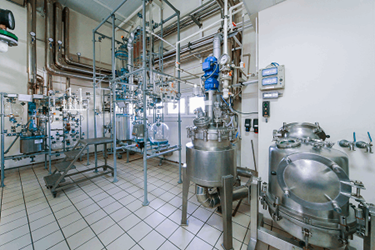An Introduction To Pharmaceutical Facility Commissioning & Qualification
By Jerry Martin

When looking at facility commissioning and qualification, it's often good to start out with understanding key words so that everybody's on the same page. When the pharmaceutical industry uses the terms “commissioning” and “qualification,” commissioning could be applied to any facility, while qualification is an aspect of commissioning that refers to a facility that will be operated under good manufacturing practice (GMP) regulations.
Thus, the first thing a pharmaceutical facility should do is familiarize itself with the requirements of various regulatory authorities related to good manufacturing practices, in addition to any relevant local or international laws, codes, and regulations. If products are to be sold in Europe, the European GMP for qualification and validation will apply, and in the U.S., the Food and Drug Administration GMP is described in 21 CFR 211.42 on building and facilities.
The U.S. regulation, 21 CFR 211.42, describes the design and construction features necessary for a pharmaceutical manufacturing facility, including the requirement that the facility will be of suitable size and construction to both meet the goals of the facility and conform to GMP regulations. This means thinking in advance about the design of the facility so that, once built, it accommodates proper cleaning, maintenance, and operations. This would include everything from properly sizing the facility to provide adequate space for placement of equipment and designing for the flow and storage of equipment and materials, to the support operations for those procedures, including utilities, packaging, labeling, and product storage.
Once design and construction and general commissioning are completed, pharmaceutical facilities must be qualified and their processes validated. Validation is the generation of documented evidence that processes are capable of consistently producing finished product that meets quality specifications. Validation is typically divided into four qualification phases: design qualification (DQ), installation qualification (IQ), operational qualification (OQ), and performance qualification (PQ).
- The DQ outlines everyone’s roles and responsibilities in developing the concept for the facility — engineering and design teams, trades, subcontractors, and suppliers — and anticipates the appropriate documentation for the premises, supporting utilities, equipment, and the processes themselves. The opposite of DQ would be designing the facility as you think might be suitable, then after construction, looking to determine whether it meets pharmaceutical GMP requirements.
Commissioning will be conducted here to ensure a correctly designed and built facility, with confirmation of water and power utility supply, HVAC systems, waste removal, etc. All of these things are part of the design for the facility, and once complete, the institution of those aspects is considered “commissioning of the facility.” By definition, this doesn’t fall under GMP, which looks only at the aspects that directly impact product manufacturing or have direct product contact.
- IQ is a process to compile a documentation package that ensures receipt and proper installation of the appropriate parts and systems of the process equipment. This includes, for example, ensuring that all equipment parts are received and assembled as required, that the electrical and water hookups and supply levels are correct, and that any other equipment necessary for the operation is installed and able to deliver per specification. Documentation ensures that not only is everything accurately installed and performing suitably but that its performance is verified per the manufacturer's specifications. If the drug sponsor assumes that equipment is made of a particular grade of stainless steel, was it actually made of that grade of stainless steel? Does the supplier have the documentation to show that grade was confirmed? That's the level of detail that the pharmaceutical manufacturer needs to address to meet regulatory requirements, whereas the commissioning agent might not examine all those confirmations.
- Once that is complete, the next phase is OQ. At this point, the testing during commissioning is evaluated to ensure that the equipment performs as specified by the manufacturer. In some cases, that can be done at the supplier (facility acceptance tests, or FATs), or it could be done after installation at the user (site acceptance tests, or SATs). Often, initial phases of OQ, including operator training, can be conducted by the equipment manufacturer, while local site requirements related to placement, local utility supply, and local operation confirmation will be done in the user’s facility.
- PQ is the final stage. It begins with a review of the DQ, IQ, and OQ documentation, then proceeds to generate data and documentation to confirm that the installed equipment can perform as the user requires it to perform.
As an example, consider purchasing an oven.DQ ensures you have adequate space, that it will be electric or gas, as specified, and that it will be equipped with the appropriate supply lines.IQ confirms you received the model you ordered and all its associated documentation.OQ confirms that if you set a temperature and time (up to maximum specifications), the oven operates as it is supposed to, and PQ confirms that whatever you want to bake comes out as intended under the required settings.In a pharmaceutical operation, the commissioning team builds and qualifies operation of the facility.The validation team confirms the facility is capable of consistently yielding product that meets its quality specifications.

Take a deeper dive into the process in Joanna Gallant's course:
From a regulatory perspective, qualification is the responsibility of the end user. With this liability, the facility owner needs to keep an eye on what they are delegating to the supplier. Because of this, much can be expected of the supplier, including quality systems as they relate to equipment fabrication; welding and the assembly, testing, and calibration of the test equipment at the supplier; and any software quality assurance associated with it.
FATs, which have some overlap with operational qualification, are crucial to ensure the supplier and end user agree upon acceptance. After shipping and installation in the pharmaceutical manufacturing facility, the SAT verifies that installation was performed correctly and operating specifications are still being met.
In summary, the commissioning of a facility, equipment, or system for operation under GMP regulations involves qualification that all operations are suitable for the intended purpose. The facility owner must have traceable verification of the systems, minimizing punchlist items to improve start-up and eliminate problems up front. Commissioning verifies that what was specified was correctly installed and that the owner can reasonably ensure that the next step verifications for this regulated industry will be successful.
The commissioning agent has that responsibility initially, but once the facility is handed over to the facility owner (contract manufacturer or drug developer), it becomes the drug developer or sponsor’s responsibility because it's a regulated pharmaceutical operation. The drug sponsor doesn’t necessarily have to repeat all of the commissioning steps, but it does need to satisfy regulators that processes are qualified and validated per GMP regulation. Almost as important, there must be complete documentation of all phases. As one FDA reviewer once famously put it, “if it's not documented, it's a rumor.”
About The Author:
 Jerry Martin is an independent consultant to pharmaceutical manufacturers and equipment suppliers for filtration, single-use manufacturing, marketing, business development, and regulatory compliance. He was previously SVP, marketing and global scientific affairs, for Pall Life Sciences, where he served the pharmaceutical, biotech, medical device, and vaccine industries for over 37 years. He is currently chairman emeritus of the Bio-Process Systems Alliance, the single-use manufacturing trade association, and a member of the USP Expert Panel on Plastic Systems Used for Manufacturing Pharmaceutical Products. He holds an M.Sc. in microbiology from the University of Toronto.
Jerry Martin is an independent consultant to pharmaceutical manufacturers and equipment suppliers for filtration, single-use manufacturing, marketing, business development, and regulatory compliance. He was previously SVP, marketing and global scientific affairs, for Pall Life Sciences, where he served the pharmaceutical, biotech, medical device, and vaccine industries for over 37 years. He is currently chairman emeritus of the Bio-Process Systems Alliance, the single-use manufacturing trade association, and a member of the USP Expert Panel on Plastic Systems Used for Manufacturing Pharmaceutical Products. He holds an M.Sc. in microbiology from the University of Toronto.
This year’s Healthcare Packaging EXPO, co-located with PACK EXPO International (Oct. 14-17; McCormick Place, Chicago) will provide attendees education and insight into the latest in pharmaceuticals and the life sciences with over 2,500 exhibitors and 50,000 industry professionals. For more information, visit packexpointernational.com or hcpechicago.com.
